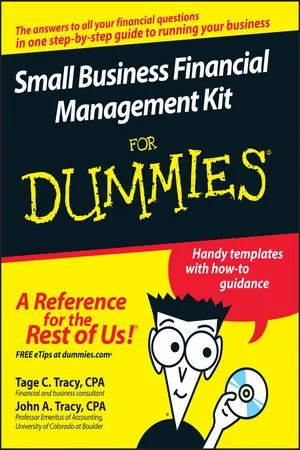Identifying Financial Management Functions
Managing the finances of a small business is not just doing one or two things. Financial management is broader than you might think — it involves a palette of functions:
Raising sufficient capital for the assets needed by your business
Earning adequate profit consistently and predictably
Managing cash flow from profit
Minimizing threats of fraud and other losses
Minimizing the income tax burden on your business and its owners
Forecasting the cash needs of your business
Keeping your financial condition in good shape and out of trouble
Putting a value on your business when the time comes
When you grow your business to 50 or 100 million dollars annual sales — and we know you will someday — you can hire a chief financial officer (CFO) to manage the financial functions of your business. In the meantime these responsibilities fall in your lap, so you better know how to manage the financial affairs of your business.
The failure rate of new businesses is high. Many entrepreneurs would like to think that if they have a good business model, boundless enthusiasm, and work tirelessly they are sure to succeed. The evidence speaks otherwise. Many embryonic businesses hit financial roadblocks because the owner/ manager does not understand how to manage the financial affairs of his or her business.
To press home our point we ask an embarrassing question: do you really have the basic skills and knowledge for managing the financial affairs of your business? Are you really on top of the financial functions that keep your business on course and out of trouble for achieving your financial objectives? Our book helps you to answer yes to these questions.
Tuning In to the Communication Styles of Financial Statements
We should be upfront about one thing: as a small business manager you must have a solid understanding of your financial statements. You can’t really manage the financial affairs of your business without having a good grip on your financial statements. There’s no getting around this requirement.
We could beat around the bush and suggest that you might be able to get along with only a minimal grasp on your financial statements. This would be a risky strategy, however. Most likely you’d end up wasting time and money. You’d have to spend too much time asking your Controller or your CPA to explain things. A CPA doesn’t come cheap. (Check with Tage, the coauthor of this book, regarding his hourly rate for advising small business clients.)
Financial statements are prepared according to established, or one could say entrenched conventions. Uniform styles and formats for reporting financial statements have evolved over the years and become generally accepted. The conventions for financial statement reporting can be compared to the design rules for highway signs and traffic signals. Without standardization there would be a lot of accidents.
It would be confusing if each business made up its own practices for presenting its financial statements. If your financial statements did not abide by these rules they would look suspect to your lenders, owners, and anyone else who sees the financials. They might question whether your accountant is competent. They may wonder what you are up to if your financial statements don’t conform to the established rules of the game.
We present many financial statements and accounting reports throughout the book. Therefore, at this early point in the book we explain the communication styles and conventions of financial statements. To illustrate these customary formats of presentation we use the P&L (profit and loss) statement shown in Table 1-1 for a business. Note: This business example is organized as a pass-through entity for income tax purposes and, therefore, does not itself pay income tax. (We discuss pass-through entities in Chapter 9.)
Table 1-1 P&L Statement for Year | Sales revenue | | $5,218,000 |
| Cost of goods sold expense | | $3,267,000 |
| Gross margin | | $1,951,000 |
| Sales and marketing expenses | $397,000 | |
| Administrative and general expenses | $1,087,000 | $1,484,000 |
| Operating profit | | $467,000 |
| Interest expense | | $186,000 |
| Net Income | | $281,000 |
The following financial statement conventions may seem evident, but then again you might not be aware of all of them:
You read a financial statement from the top down.
Sales revenue is listed first, which is the gross (total) income from the sale of products and services before any expenses are deducted. If the main revenue stream of the business is from selling products the first expense deducted from sales revenue is
cost of goods sold, as in this example.
Deducting cost of goods sold expense from sales revenue gives gross margin (also called gross profit). The number of other expense lines in a P&L statement varies from business to business. Before interest expense is deducted the standard practice is to show operating profit (also called operating earnings), which is profit before interest expense.
The sample P&L statement includes two columns of numbers. Note that the $1,484,000 total of the two operating expenses (that is, sales and marketing expenses plus administrative and general expenses) in the left column is entered in the right column. Some financial statements display all figures in a single column.
An amount that is deducted from another amount — such as the cost of goods sold expense — may be pl...














-plgo-compressed.webp)



